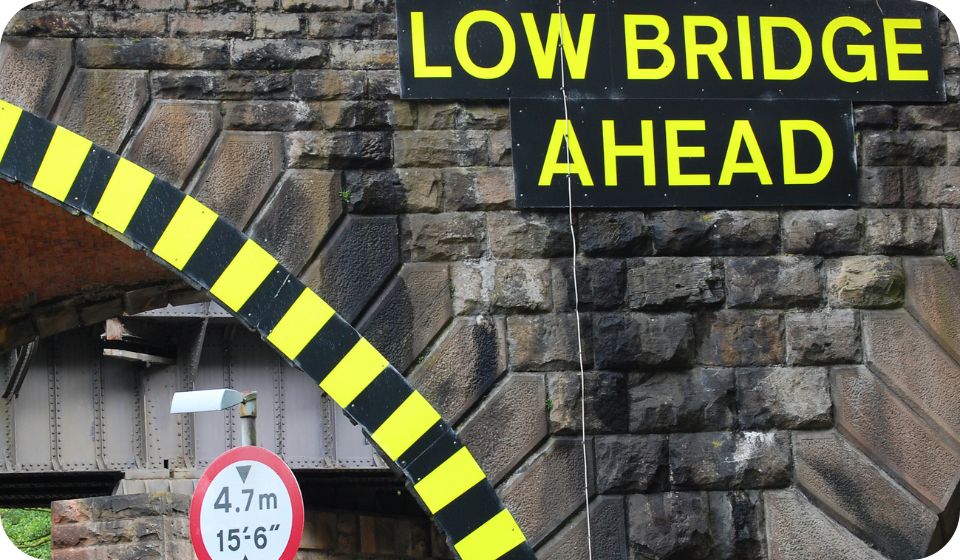Bridge strikes are a critical and persistent hazard within the transport industry, significantly affecting safety, financial stability, and operational efficiency.
These incidents – where vehicles collide with overpass structures – cause disruptions that ripple across multiple levels of infrastructure and services. The stakes are high, and each bridge strike incident can lead to extensive physical damage, pose severe risks to driver and public safety, and result in economic losses due to delays and repairs.
In our latest blog, we explore the concept of static hazards, delving into the phenomenon of bridge strikes, examining their causes, detailing their impacts, and discussing comprehensive strategies to prevent them.

Understanding driver hazard warnings: Static vs Dynamic
The first step in preventing accidents like bridge strikes is understanding the two main types of hazards: static and dynamic.
Static Hazards are constant; they do not change location or condition over time and examples include:

1. Bridge Strikes:
These incidents occur when the height of a vehicle exceeds the clearance of a bridge, leading to potentially catastrophic outcomes.

2. Weight Restrictions:
Some roads and bridges impose weight limits that, if exceeded, could lead to structural damage or even collapse.

3. Width Restrictions:
Similar to height and weight, certain passages may have limitations on the width of vehicles allowed, which are essential for drivers manoeuvring through narrow streets or between constructions.
In contrast, Dynamic Hazards are variable and can change based on weather, traffic, or the time of day. Examples include:

1. Vulnerable Road Users (VRUs):
Dynamic warnings help to highlight VRUs, including cyclists and motorcyclists who are in proximity but may not be immediately apparent to a driver.

2. Weather Changes:
Conditions such as ice, snow, heavy rain, or fog can significantly impact road safety, making it more difficult to adapt to the presence of VRU’s or a damaged road surface in enough time to stay safe.

3. Physical Road Conditions:
Hazardous road conditions such as debris, road damage, and potholes can be difficult to spot and appear at any time.
What is a bridge strike?
Put simply, a bridge strike occurs when a vehicle collides with a bridge because the clearance height of the bridge is lower than the height of the vehicle attempting to pass underneath it.
This seemingly straightforward issue is fraught with complexity and consequence, making it a persistent challenge despite its preventable nature.
Despite their severe impact, bridge strikes are alarmingly common. In the UK, for instance, there are around 1,800 bridge strikes annually, highlighting a significant area of concern for transport safety and infrastructure maintenance.
The regularity of these incidents underscores a crucial point: bridge strikes are largely preventable. Better awareness of vehicle dimensions, attentive compliance with road signage, and adequate route planning are fundamental measures that can drastically reduce the occurrence of these dangerous incidents.
Common causes, risks and consequences
Common causes:
Bridge strikes most commonly involve large vehicles – such as HGVs, trucks, and buses – which due to their substantial height, are at risk of misjudging height. In some situations, drivers are simply unaware of bridge clearance levels.
These incidents are serious safety hazards with the potential to cause severe damage to both the vehicle and the bridge structure.
Common risks:
The associated risks extend beyond the immediate physical damage.
For road traffic, a bridge strike can lead to debris on the road, immediate traffic delays, and long-term road closures for repair work, all of which contribute to significant logistical disruptions.
For rail traffic, the stakes are even higher. Many bridges span railway lines, so a strike not only endangers road users but can also pose a derailment risk to trains, threatening passenger safety and causing extensive delays in rail services.
Common consequences:
Bridge strikes are not only disruptive but can also have severe and far-reaching consequences. And understanding these impacts is crucial in order to understand the importance of preventing such incidents.
The most common consequences include:

1. Structural Damage and Economic Costs:
One of the immediate effects of a bridge strike is significant structural damage to the bridge itself. This damage often requires extensive and costly repairs to ensure the bridge remains safe and functional.
The financial burden of these repairs is substantial, with the average cost to the UK taxpayer for each bridge strike incident being approximately £13,500, totalling around £27 million each year. These figures represent a considerable strain on public resources.

2. Traffic Disruption:
Bridge strikes typically lead to considerable traffic delays. As roads or lanes are closed for repair work, traffic congestion can increase dramatically, disrupting local and regional travel.
The knock-on effects include lost time for commuters and increased operational costs for businesses relying on freight transport, which can affect service delivery and supply chains.

3. Safety Risks
Perhaps the most critical consequence of bridge strikes is the risk to human safety. In cases where bridges over railway lines are struck, there is a potential for catastrophic outcomes, including train derailments.
Such incidents not only pose a high risk of injury to train passengers and staff but can also lead to fatalities. Debris from a strike can also pose hazards to other road users, potentially leading to accidents and injuries.
Bridge heights in the UK
In the UK, bridge heights are not uniform and can vary widely depending on the type of road, the age of the infrastructure, and the specific geographical and urban planning considerations of the area.
This variability requires drivers – especially those operating high-sided vehicles – to be vigilant and well-informed about the typical bridge clearances they might encounter. Road types to consider include:
Motorways
Motorways are designed to support high-speed travel and accommodate a high volume of traffic, including large commercial vehicles.
Consequently, bridges over motorways typically offer higher clearances, often exceeding 16 feet (about 4.9 meters). This design standard helps to ensure that motorways can safely facilitate the vast majority of commercial transport vehicles.
Dual carriageways and A-roads
Dual carriageways and A-roads serve as major arteries for both urban and rural traffic, linking cities and regions across the UK. Bridges on these roads usually provide sufficient clearance for most traffic; however, they can vary more than those on motorways.
While many are modern and built with high clearances, others, especially in historical or rural areas, might feature older bridge constructions with lower clearances.
Residential areas and older city parts
In residential areas and the older parts of cities, bridge clearances can be particularly challenging for drivers of large vehicles.
Many of these bridges were built in eras when the average vehicle height was considerably lower than it is today. As a result, these bridges may have clearances as low as 12 feet (about 3.7 meters) or even less, significantly increasing the risk of bridge strikes.
Awareness, planning and prevention
The varied landscape of UK bridge heights presents a considerable challenge for transport operators. Ensuring safety and preventing incidents requires both awareness and proactive planning – and the implementation of preventive technologies.
Route planning and vehicle awareness
Effective route planning is paramount for drivers and fleet operators. This planning should start with a clear understanding of the vehicle’s dimensions – particularly height – and matching this knowledge against potential hazards on intended routes.
For drivers, especially those navigating through unfamiliar areas, knowing the height restrictions of bridges along potential routes is crucial. This awareness allows drivers to reroute ahead of time, preventing strikes from occurring.
Use of technology
Leveraging technology can dramatically improve safety measures, and up-to-date satellite navigation systems that include detailed clearance information are indispensable tools. These systems can alert drivers to upcoming low bridges, giving them sufficient time to adjust their routes.
Going one step further, the adoption of specialised apps that focus on providing real-time alerts for low bridges – and other static hazards – can make a big difference. These tools integrate GPS data with a vehicle’s dimension data, offering tailored warnings that help drivers navigate safely.
Training and compliance
In addition to technology, transport companies are responsible for ensuring their drivers are properly trained. This training should include understanding vehicle dimensions, recognising the limitations these dimensions may impose, and learning to adhere to route restrictions based on bridge heights.
Training should also emphasise the importance of compliance with traffic signs and road markings, which are critical to navigating UK roads safely.
What to do if you're involved in a bridge strike
Being involved in a bridge strike can be a distressing and dangerous situation. It is essential to handle the incident with a clear and structured approach to mitigate further risks and complications.
Here’s what to do if you find yourself in this situation:
1. Prioritise safety
Safety should always be your first priority. Assess the situation to ensure that you and any passengers are unharmed. Check for potential hazards like loose debris, damage to the vehicle that may pose immediate risks, or any structural damage to the bridge that could affect other road or rail users.
2. Secure the scene
Once safe to do so, secure the scene to prevent further accidents. This may involve setting up warning triangles or flares to alert other drivers, especially if the strike has caused obstruction or debris on the road.
3. Contact emergency services
If there are injuries or significant structural damage, call the emergency services immediately. Provide them with precise details about the location and nature of the incident.
4. Notify the company's head office
Contact your company’s head office to report the incident. Provide a detailed account of the event, including any steps already taken and the status of the vehicle and bridge.
5. Document the incident
This is an important step for insurance and legal purposes. Take photographs of the scene, the damage to the vehicle and the bridge, and any relevant road signs or obstructions that may have contributed to the incident.
6. DO NOT Remove the Vehicle Without Clearance
Don’t attempt to move the vehicle from under the bridge unless it is confirmed safe by the authorities. Moving the vehicle without proper assessment can lead to further damage to a) the structure or b) the vehicle itself.
By following these structured steps, drivers can effectively manage the situation if involved in a bridge strike, minimising harm to themselves and others, and ensuring a coordinated response to the incident.





